GWSS Biological Control Agents
Preliminary field observations in native and introduced range of GWSS resulted in the decision to prioritize egg parasitoids for evaluation as biological control agents. Dr. Serguei Triapitsyn (University of California, Riverside), and Larry Bezark (CDFA) made the first trips to Mexico in search of GWSS egg parasitoids in 1999. In 2000 and following years, CDFA (Drs. Morgan and Pickett), USDA-APHIS (Dr. Simmons), USDA-ARS (Dr. Walker Jones), and the Universdad Autonomata de Tamaulipas (Dr. Svetlana Myartseva) made further collections of proconiine egg masses in NE Mexico and SE USA. Permits were issued to transport the egg masses to quarantine facilities in California and Texas where they were incubated and examined daily for the emergence of egg parasitoids. Any parasitoids emerging were identified, then exposed to fresh GWSS egg masses to ensure that they could successfully develop on egg masses obtained from Californian populations of GWSS.
Once stable populations of egg parasitoid species had been established in quarantine, they were evaluated for their suitability as GWSS biological control agents. Attributes such as longevity, fecundity, and host specificity (choice and no-choice) were examined before submitting requests to the USDA-APHIS for permission to release the selected biological control agents into California.
This section describes some of the characteristics of parasitoids selected for release into California and rationale for selecting them. Six species or populations of GWSS egg parasitoid have been released into California since the initiation of the PDCP, these are:
Other egg parasitoids were also evaluated for use as biological control agents, including parasitoids from North and South America.
Cosmocomoidea triguttata
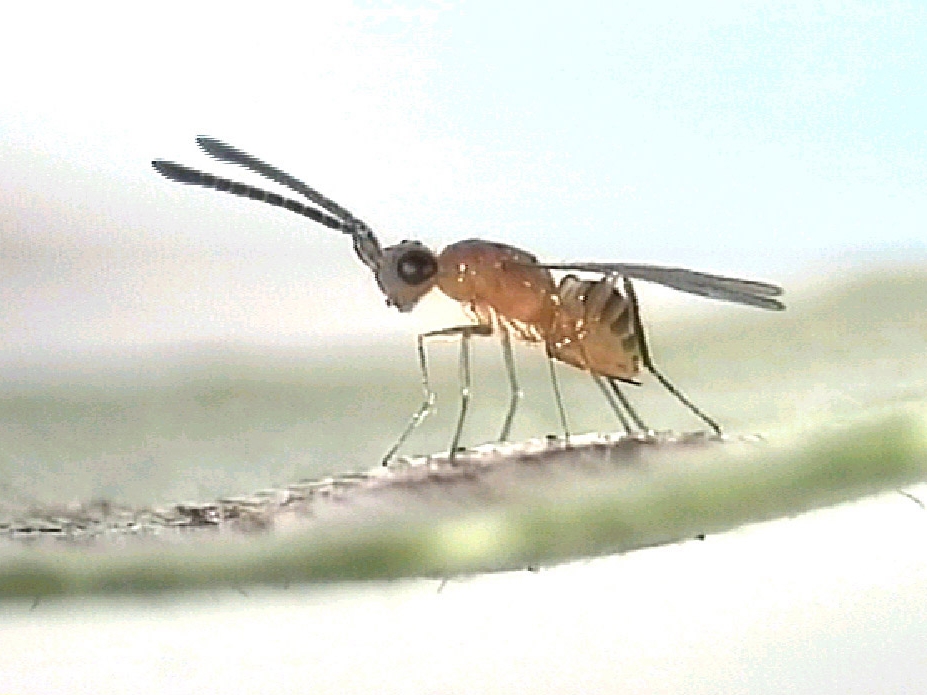
Cosmocomoidea triguttata -
This wasp can successfully
parasitize the native
smoke tree sharpshooter.
When first explorations were made in Mexico and SE USA, this insect was the most commonly collected natural enemy of GWSS in its native range. It produces one wasp per GWSS egg (solitary wasp) and offspring are female sex-biased.
This parasitoid can successfully parasitize the native smoke tree sharpshooter but does not fare well in desert conditions where the native sharpshooter is commonly found. This takes 12-14 days to develop from egg to adult. Adults mate upon emergence. Then females disperse to search for GWSS eggs to parasitize. Adults feed on sugar sources to increase longevity. This insect was selected because of its importance as a natural enemy in the GWSS native range.
Back to the list of parasitoidCosmocomoidea ashmeadi
Populations of C. ashmeadi already exist in California. Research carried out by Drs. Stouthamer and Hoddle suggest that it is not native to California but arrived in California prior to 1980, long before the arrival of GWSS, and became established on the smoke tree sharpshooter. When GWSS arrived in California, the parasitoid switched back to its supposed evolutionary host where is now the most important natural enemy of GWSS in California.
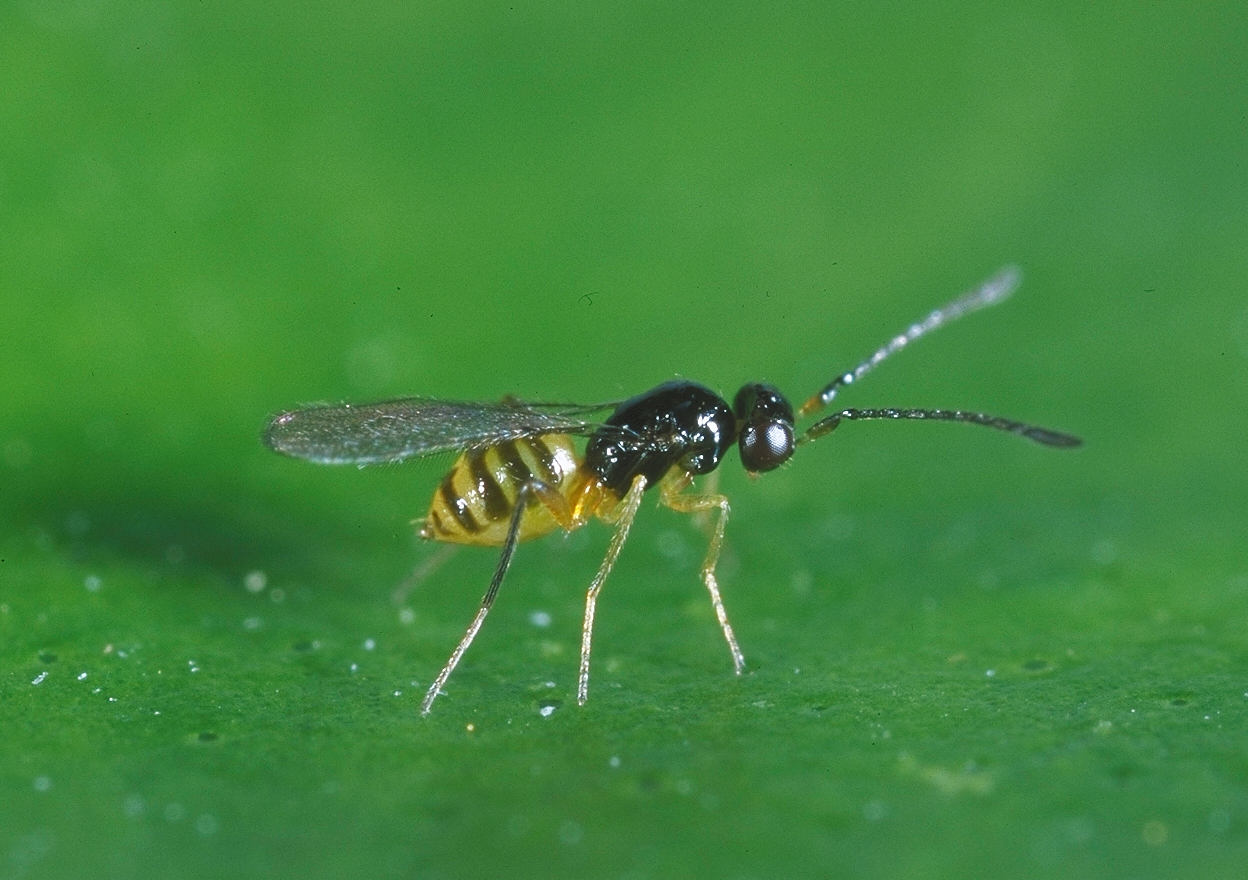
Cosmocomoidea ashmeadi -
A wasp used to help in the
fight against GWSS.
Populations of C. ashmeadi were recovered in the southeastern USA and northeastern Mexico and, after appropriate screening, were released into California. The rationale for the release of exotic populations of C. ashmeadi was that this population might have attributes that made is a more efficient GWSS parasitoid than the California population, which may have evolved to being a more effective natural enemy of the smoke tree sharpshooter. It is hoped that the best attributes of each population would eventually combine, resulting in higher levels of parasitism of GWSS. Unfortunately, it is impossible to discriminate between native and non-native populations of C. ashmeadi so testing such a hypothesis was not possible.
Cosmocomoidea ashmeadi and C. triguttata have similar life histories. Although the former appears to be competitively superior under laboratory conditions, C. triguttata may be a more effective biological control agent in the field, where there are variable biotic (e.g. host plant factors) and abiotic (e.g. climatic conditions) factors to significantly impact the competitiveness.
Back to the list of parasitoidCosmocomoidea walkerjonesi
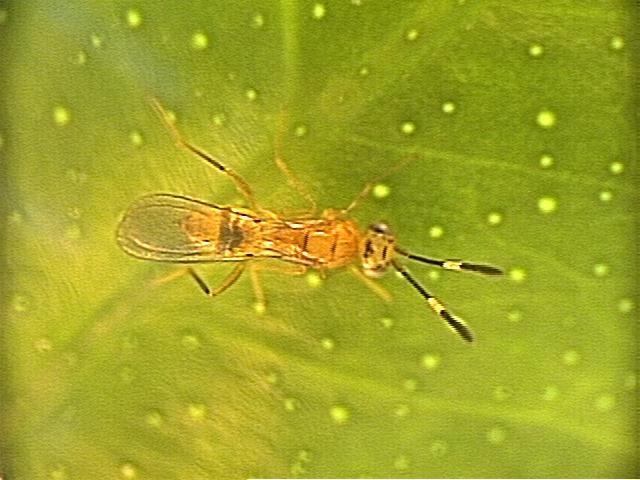
Cosmocomoidea walkerjonesi -
A wasp used to help in the
fight against GWSS.
A species of Cosmocomoidea was recovered from Mexico in 2000 and evaluated as previously described. This insect was identified as being identical to a California species of Cosmocomoidea and so when permits were issued for its release, populations of field insects from California were added to augment production rate. It was a few years later that the two populations mixed were, in fact, two different species and that the Californian species, C. walkerjonesi was previously undescribed. It is believed that the Mexico species, C. morrilli, soon became extinct in the wasp production system due to being outnumbered by additions of C. walkerjonesi to the colonies. Consequently, C. walkerjonesi was released into California for four years before the colony was reinitiated with G. morrilli from Mexico.
Back to the list of parasitoidCosmocomoidea morrilli
Releases of the true C. morrilli were initiated in 2005. This insect has a considerably faster development rate than any of the previously described congeners, emerging about two days earlier. This faster lifecycle raised the possibility that the insect could build up populations faster in the spring prior to the buildup of other egg parasitoids. Although it has not been long since releases were initiated, we are already getting positive signs that this insect has become established in California.
Back to the list of parasitoidCosmocomoidea fasciatus
When this insect was first collected in Louisiana, there were high hopes that it would prove an efficient early season biological control agent. In its native range, the insect becomes the predominant natural enemy of GWSS eggs for over a month before it is replaced by C. ashmeadi.
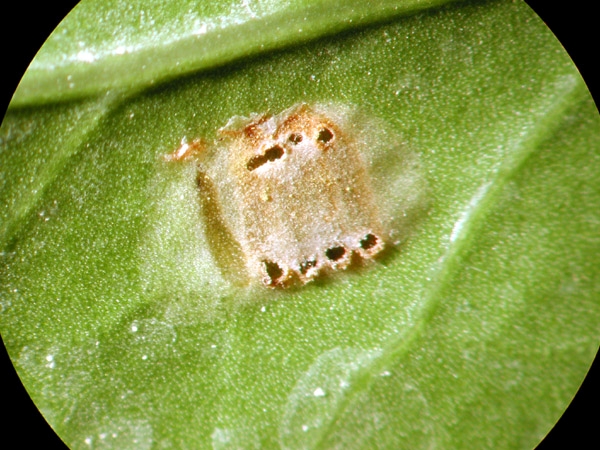
A GWSS egg mass that
wasps possibly have
emerged from.
The insect has one major attribute that benefit it over the other species of Gonatocerus described; it is gregarious, in other words, more than one wasp emerges from each GWSS egg parasitized. Initially it was thought that only two wasps emerged from each GWSS egg but it was soon found that up to seven wasps could emerge from each egg. The other individuals emerging from one of the two emergence holes cut at each end of the GWSS egg. The ability to produce more than one offspring from each GWSS egg favors the rapid buildup of populations of this insect, especially when host density is low (i.e. early in the year) so search time for egg masses is a major investment. Cosmocomoidea fasciata is, not surprisingly, smaller than its congeners and consequently has a shorter adult longevity of about a week compared to two weeks.
This insect was permitted for release into California and the CDFA spent three years attempting to get it established. During this time several discoveries were made about this insect. Under laboratory conditions, they successfully parasitized the smaller native blue-green sharpshooter, but this species was never observed in the field. Also, it was discovered that this insect was, after all, native to California; individual specimens have been repeatedly collected in Northern California where it is supposed to attack sharpshooter species confined to that area.
Back to the list of parasitoidAnagrus epos
The search for a biological control agent that could overwinter lead to the discovery of A. epos in Minnesota on the border of North Dakota. A literature search revealed that this species had previously been permitted for release as a biological control agent of the beet leafhopper but later publications corrected this as a misidentification of a new species. These insects are extremely small so there are few characteristics that can be used to discriminate between species.
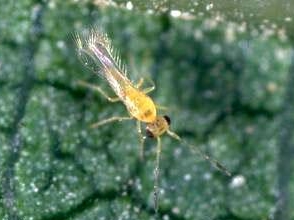
Anagrus epos -
can produce up to 14
individuals from one
GWSS egg.
Although A. epos is in the same family as Cosmocomoidea, the Mymaridae has a considerably different life history. It is believed to be univoltine in its native range; its evolutionary host is a smaller sharpshooter than GWSS in the genus Cuerna. The optimal conditions for development of this species are considerably lower than for Gonatocerus spp and development time can take over a month. Nonetheless, the ability to overwinter and produce up to 14 wasps from one GWSS egg (gregarious parasitoid) makes it an interesting candidate for GWSS biological control. Because A. epos can parasitize other sharpshooter species, studies are underway to develop production techniques that employ hosts that are easier to rear than GWSS, producing up to 14 individuals from one GWSS egg (gregarious parasitoid).
Back to the list of parasitoidNorth America
Recent field-exploration trips were made by researchers at Texas A&M University into Mexico. Several species of egg parasitoids were recovered, one of which is a new species and is currently undergoing evaluation in quarantine at UC Riverside.
Closer to home, during the process of monitoring field release sites, a new species of Cosmocomoidea was discovered at one location in Orange County in 2002. In a publication describing the insect, it was suggested that it is exotic to California as it has a number of characteristics that suggest its origin to be Central America. Since then, C. morgani has spread southward along the coast to San Diego. Attempts are underway to establish a colony of the parasitoid so that releases can be made into areas that are geographically isolated from its current range, for instance Ventura which is isolated by the city of Los Angeles and inland areas that are isolated by mountain and hill ranges.
Similar work is being carried out on the trichogrammatids Ufens spp. that are desert specialists and previously confined to the desert regions east of Los Angeles. These insects have well known to be nearly impossible to rear. Wasps emerging from field-collected, parasitized GWSS eggs are collected and relocated to distant release sites. The releases had been made to native vegetation in the San Joquin Valley as these insects appear to be most effective at parasitizing eggs laid in native host plants and in desert environments, and these species appears to have well established in the San Joaquin Valley. They were lately found from the fields in San Diego County and Ventura County.
Back to the list of parasitoidSouth America
One of the more controversial aspects of biological control being evaluated by the PDCP is the introduction of exotic natural enemies for control of a sharpshooter with which they have had no evolutionary association. This technique is called neoclassical biological control and has had its successes but also has critics. Several South American species of egg parasitoid have been collected from proconiine sharpshooter eggs and sent to California and Texas quarantine facilities for evaluation. Two concerns have been raised regarding the release of biological control agents from South America. The first is that the agents would not add to the level of biological control being attained in California from agents and natural enemies already present. In fact, some have suggested that the introduction of a new species might even depress the level of control due to competition effects between parasitoids. The second is that there is, however small, the risk that the introduced agent may be inadvertently introduced into the native range of GWSS and might disrupt the ecological balance of native proconiine sharpshooters and their natural enemies. These issues need to be addressed, and such risks balanced against the potential benefits to be gained by introducing a neoclassical biological control agent.
Back to the list of parasitoid
